Chapter 7: Consumer Buying Behavior & The Customer Journey
Learning Objectives
After reviewing this information, you will be able to:
- Define consumer buying behavior.
- Explain the nature of the buyer’s black box.
- Explain the key factors that influence consumer behavior and decision-making: cultural, societal, personal, psychological and situational.
- Understand the stages of the customer buying process and how service can influence outcomes.
- Identify and analyze the components of a customer journey map, distinguishing between marketing and service-driven touchpoints.
- Apply customer journey mapping to improve service delivery and customer satisfaction.
Consumer Buying Behavior Defined
How many buying decisions did you make today? Perhaps you stopped on the way to work or class to buy a soft drink or coffee, went to the grocery store on the way home to get bread or milk, or ordered something online. You likely make buying decisions nearly every day and probably don’t give most of those decisions much thought. But how you make those decisions is significant for business owners, marketers, and customer-facing staff because if they can understand why you buy what you buy and when you buy it, they can use that information to enhance customer service and satisfaction…and boost revenue.
Consumer buying behavior refers to the decisions and actions people undertake to buy products or services for personal use. In other words, it’s the actions you take before buying a product or service, and as you will see, many factors influence that behavior. You and all other consumers combine to make up the consumer market.
The Buyer’s Black Box
It stands to reason that the hundreds of millions of people who make up the global consumer market don’t all buy the same products and services. Why do certain people prefer different items than others? The answer lies in the factors that influence consumer buying behavior. One model of consumer buying behavior is what’s known as the buyer’s black box, which is named as such because little is known about what goes on in the human mind. It’s also known as the stimulus-response model.
As illustrated in the model shown in Figure 3.1 consumer buying behavior is based on stimuli coming from a variety of sources—from marketers in terms of the 4Ps (product, price, promotion, and place), as well as from environmental stimuli, such as economic factors, legal/political factors, and technological and cultural factors.
These stimuli go into your “black box,” which consists of two parts: buyer characteristics such as beliefs and attitudes, motives, perceptions, and values, and the buyer decision-making process, which is covered later in the chapter. Your response is the outcome of the thinking that takes place in that black box. What will you buy, where, when, how often, and how much?

Types of Consumer Buying Behavior
Buying behavior is not influenced solely by the external environment. It’s also determined by your level of involvement in a purchase and the amount of risk involved in the purchase. There are four types of consumer buying behavior, as shown below:
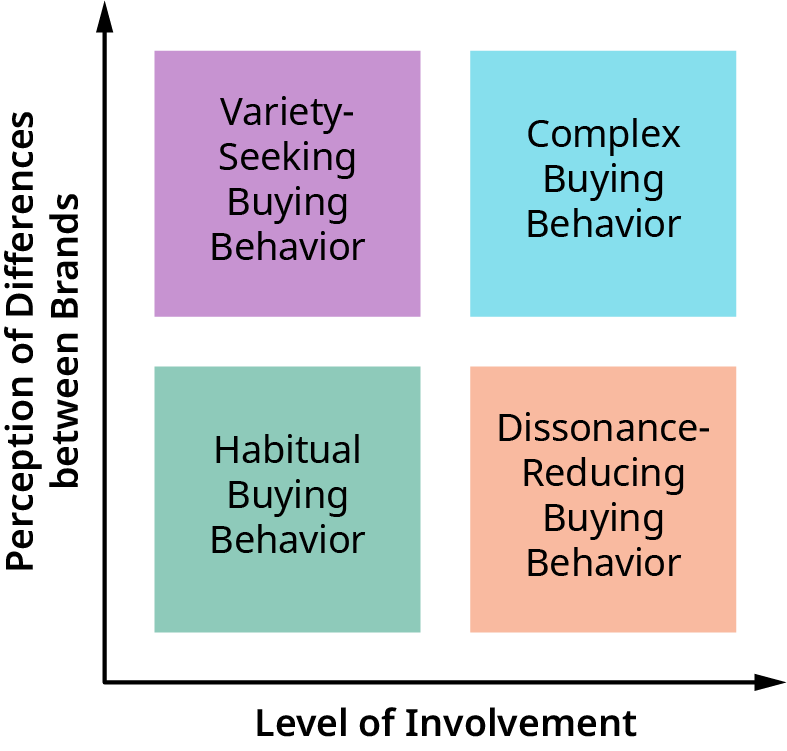
Complex buying behavior occurs when you make a significant or expensive purchase, like buying a new car. Because you likely don’t buy a new car frequently, you’re highly involved in the buying decision, and you probably research different vehicles or talk with friends or family before reaching your decision. By that time, you’re likely convinced that there’s a significant difference among cars, and you’ve developed your own unique set of criteria that helps you decide on your purchase.
Dissonance-reducing buying behavior occurs when you’re highly involved in a purchase but see little difference among brands. Let’s say you’re replacing the flooring in your kitchen with ceramic tile—another expensive, infrequent purchase. You might think that all brands of ceramic tile in a certain price range are “about the same,” so you might shop around to see what’s available, but you’ll probably buy rather quickly, perhaps as a result of a good price or availability. However, after you’ve made your purchase, you may experience post-purchase dissonance (also known as buyer’s remorse) when you notice some disadvantages of the tile you purchased or hear good things about a brand you didn’t purchase.
Habitual buying behavior has low involvement in the purchase decision because it’s often a repeat buy, and you don’t perceive much brand differentiation. Perhaps you usually buy a certain brand of organic milk, but you don’t have strong brand loyalty. If your regular brand isn’t available at the store or another brand is on sale, you’ll probably buy a different brand.
Variety-seeking buying behavior has the lowest customer involvement because brand switching is your norm. You may not be unhappy with your last purchase of tortilla chips, but you simply want to try something new. It’s a matter of brand switching for the sake of variety rather than because of dissatisfaction with your previous purchase.
The 4Ps and Consumer Behavior
Watch this short, humorous 4Ps video as a way to help you remember the concept. This video also includes several examples of target markets and how a marketer might respond.
Influences on Consumer Buying Behavior
Cultural Influences
Why people buy isn’t always a straightforward question. Think about the last time you bought a car, a bike, or other item. Why did you buy that specific make and model? Was it because its sleek style made you feel good about yourself? Perhaps you bought a particular brand because someone in your family bought the same brand. These are just a couple of examples of some of the factors that influence consumer buying behavior. Let’s examine some others.
Cultural factors comprise a set of values or ideologies of a particular community or group of individuals. These can include culture, subcultures, social class, and gender as outlined below.

A subculture is a group of people, such as environmentalists or bodybuilders, who share a set of values. Ethnic and racial groups share the language, food, and culture of their heritage. Other subcultures, like the biker culture, which revolves around a dedication to motorcycles, are united by shared experiences. The Amish subculture is known for its conservative beliefs and reluctance to adapt to modern technology. Think about what subculture(s) you may belong to and how they influence your buying behavior. For example, hip-hop music has long been associated with fashion, particularly sneakers. Run DMC’s 1986 hit “My Adidas” led to the first endorsement deal between a fashion brand and a musical act, setting the stage for lucrative partnerships spanning the decades since—Master P with Converse, Jay-Z and 50 Cent with Reebok, Missy Elliott and Big Sean with Adidas, and Drake with Nike.
Your social class is also an important influence on your buying behavior. Sociologists base definitions of social class on several different factors, including income, occupation, and education. While there is disagreement on the number of social classes defined by income in the United States, many sociologists suggest five social classes: upper class, upper-middle class, lower-middle class, working class, and the economically disadvantaged.3
Income is largely defined by disposable income (the money you have left to spend or save after taxes are deducted), but its influence goes beyond just dollars, euros, yen, etc. For example, a lower-middle-class individual might focus primarily on price when considering a product, whereas an upper-middle-class person might consider product quality and features before price. However, you also can be influenced by a social class to which you don’t belong but by which you want to be accepted. Have you ever spent money you really didn’t have on brand name running shoes or a designer purse because that’s what your friends have?
Finally, your gender plays an important role in your buying behavior. People of different genders not only want different products as a result of their upbringing and socialization, but they approach shopping itself with different motives, perspectives, and considerations. While it’s always dangerous to stereotype, those who identify as male typically follow a utilitarian, more logic-based approach when shopping. They want a quick, effortless shopping experience. Those who identify as female, on the other hand, make decisions on a more emotional level. Zappos considers these different motives and provides different layouts on their landing pages for different genders. While the “male” version focuses on providing clear navigation by product categories, the “female” version aims to sell on emotion. [2]
Social Factors That Influence Consumer Buying Behavior
Social factors are those factors that are prevalent in the society where the consumer lives. Every society is composed of individuals who have different preferences and behaviors, and these individuals influence the personal preferences of others in the society. Humans are social individuals, and the influences of people’s family, reference groups, and roles and status have a huge impact on their buying behavior.
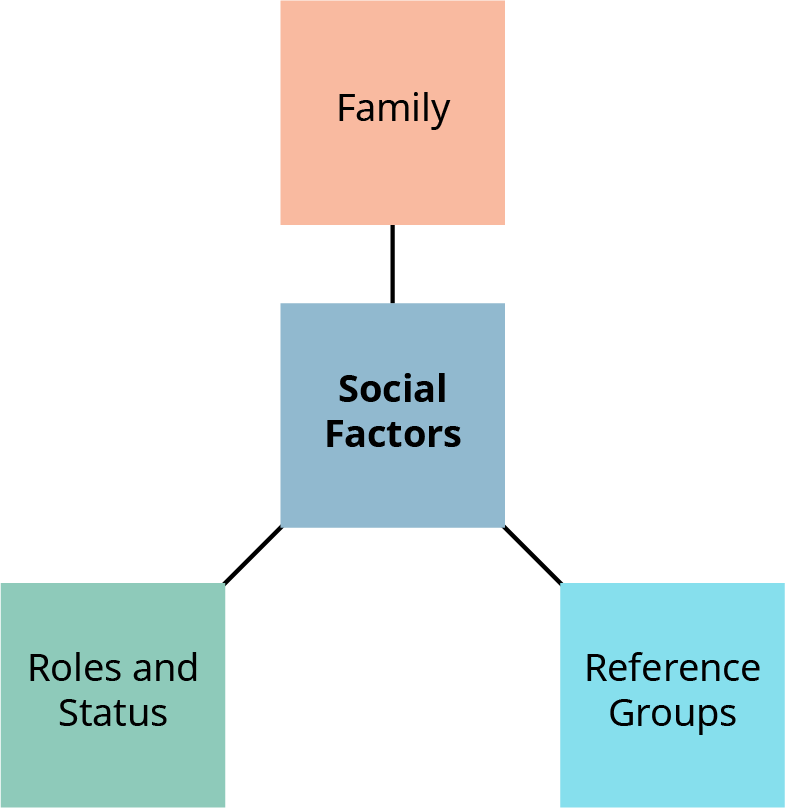
Let’s first consider the influence of family. It is generally believed that most people pass through two families: a family of orientation (i.e., the family to which you were born or with whom you grew up) and a family of procreation (the family formed through marriage or cohabitation, including your spouse, partner, and/or children). Consider first the family of orientation. When you were growing up, whether or not you recognized it, you likely developed some degree of buying behavior through watching adult members of your household and probably tend to buy the same products or services as you grow older. Was your father a die-hard Chevy driver? If so, the chances are good that you’ll probably at least consider buying a Chevy, too. Now consider the influence that your spouse, partner, and/or children have on your buying behavior. You may want that Chevy pickup because that’s what your father drove, but your spouse or partner may subtly (or perhaps not so subtly) sway you toward a Chevy crossover SUV because it’s more practical with kids to transport to school, sports, and other activities.
Reference groups are those groups with which you like to be associated. These can be formal groups, such as members of a country club, church, or professional group, or informal groups of friends or acquaintances. These groups serve as role models and inspirations, and they influence what types of products you buy and which brands you choose. Reference groups are characterized by having opinion leaders—people who influence others. These opinion leaders aren’t necessarily higher-income or better educated, but others view them as having more expertise in a particular area. For example, a teenage girl may look to the opinion leader in her reference group of friends for fashion guidance, or a college student might aspire to getting an advanced degree from the same university as an admired professor. Social media influencers also play a role here. Consider the influence that celebrities like Kendall Jenner (with more than 217 million Instagram followers)[3] or Leo Messi (with over 310 million Instagram followers)[4] have on individuals.
All people assume different roles and status depending upon the groups, clubs, family, or organizations to which they belong. For example, a working mother who is taking classes at the local community college assumes three roles at varying times—that of an employee, a mother, and a student. Her buying decisions will be influenced by each of these roles at different times. When she is shopping for clothing, her purchases may be influenced by any or all of these roles—professional attire for the office, casual clothes for classes, or yoga pants for home.
Personal Factors That Impact Consumer Buying Behavior
Personal factors, such as your occupation, age and life cycle stage, economic situation, lifestyle, and personality and self-concept also play a major role in your buying behavior. Let’s examine each of these in more detail.
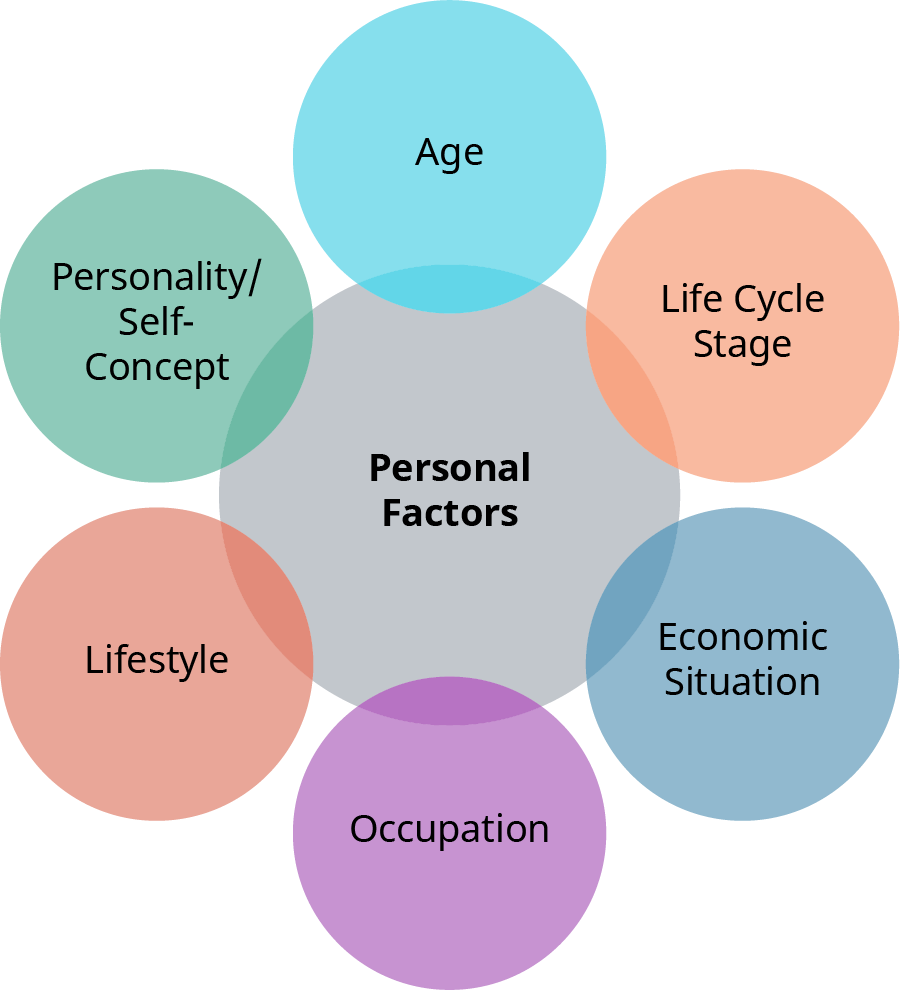
Age is a major factor that influences buying behavior because consumer needs and wants change with age. Your buying habits as a teenager or twentysomething are likely to be vastly different from your buying habits in middle age and beyond. Consider the four generational cohorts currently comprising the consumer market:
Likewise, your life cycle stage has a major influence on your buying habits. Consider the different buying choices you would make as a single person who is renting an apartment in an urban area versus the choices you would make as a homeowner in the suburbs with children. It should be noted, though, that age and life cycle stage can often be poor predictors of buying behavior. For example, some 40-year-olds are just starting their families, while others are sending their kids off to college. Still other 40-year-olds are single (or single again). Some 70-year-olds may fit the stereotype of a retired person with a fixed income; others are still active or perhaps still working, with plenty of disposable income.
Your economic situation (income) is a huge influence on your buying behavior. Higher income typically means higher disposable income, and that disposable income gives consumers more opportunity to spend on high-end products. Conversely, lower-income and middle-income consumers spend most of their income on basic needs such as groceries and clothing.
Your occupation is also a significant factor in your buying behavior because you tend to purchase things that are appropriate to your profession. For instance, a blue-collar worker is less likely to buy professional attire like business suits, whereas attorneys, accountants, and other white-collar workers may favor suits or business casual work clothes. There are even companies that specialize in work clothes for certain types of workers, such as health care professionals who buy scrubs or construction workers who buy steel-toed boots.
Your lifestyle reflects your attitudes and values. What do you consider to be your lifestyle? Do you strive to live an active, healthy lifestyle? If so, your purchasing decisions may focus on healthier food alternatives instead of fast food. Do you consider yourself to be a soccer parent? You may (perhaps reluctantly) forgo that sports car for a minivan to transport your kids to youth sporting events or other activities.
Your personality and self-concept are also important factors influencing your buying behavior. Personality is the characteristic patterns of thoughts, feelings, and behaviors that make a person unique. It’s believed that personality arises from within the individual and remains fairly consistent throughout life.[5] Some examples of the many personality traits people might have include things like self-confidence, individualism, extroversion, introversion, aggression, or competitiveness. Your personality greatly influences what you buy as well as when and how you use or consume products and services.
Perhaps even more importantly, as consumers, people tend to buy not only products they need but also those products or services that they perceive as being consistent with their “self-concept.” In other words, they generally want the products they buy to match or blend in with who they think they are.[6]
Psychological Factors That Influence Consumer Buying Behavior
Your buying choices are further influenced by several major psychological factors, including motivation, perception, learning, feelings, beliefs, and attitudes.
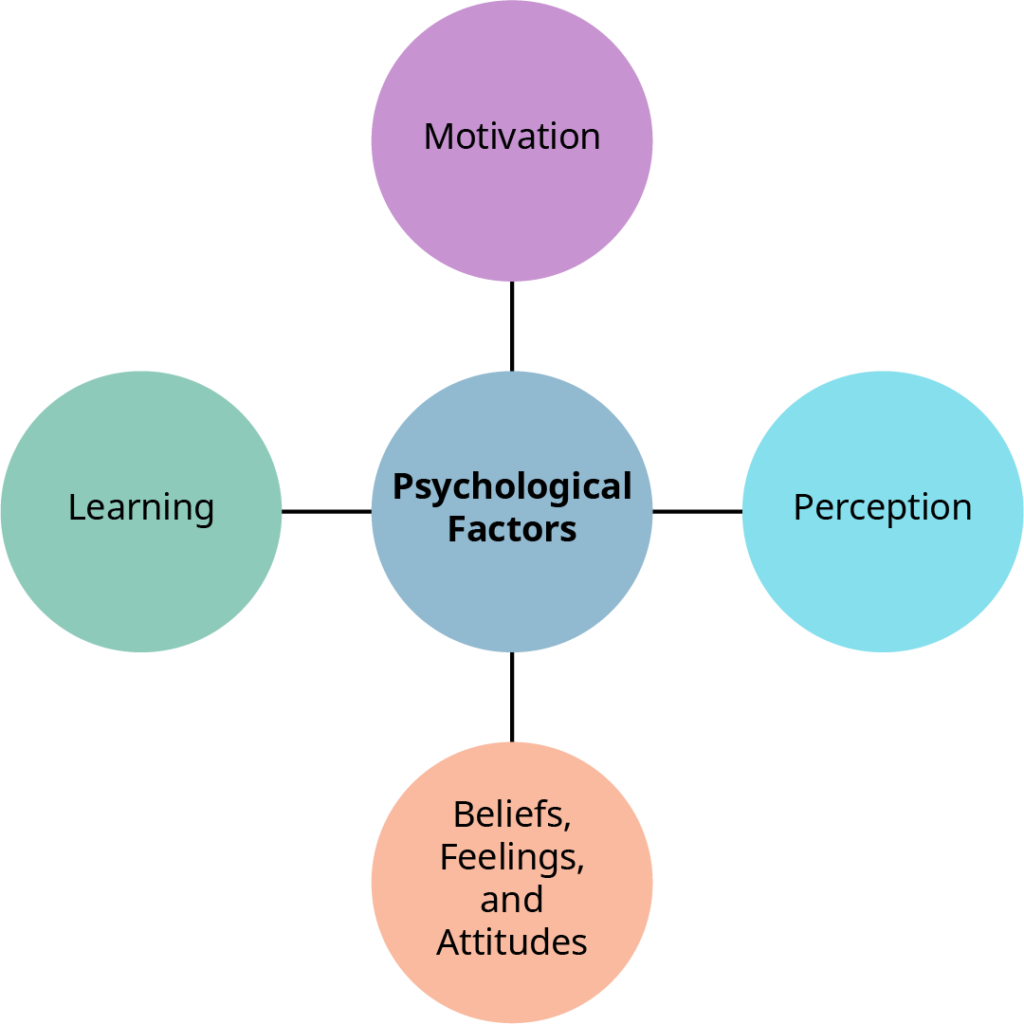
Let’s first consider how motivation affects your buying behavior. Motivation is the process that initiates, guides, and maintains goal-oriented behaviors. It’s the driving force behind your actions. One of the most widely known motivation theories is Maslow’s hierarchy of needs.
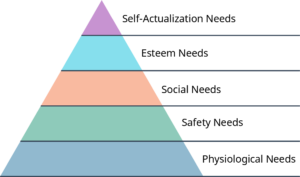
Abraham Maslow asserted that all individuals have five needs, arranged from the most basic lower-level deficiency needs to the highest-level growth needs. As Figure 7.7 shows, physiological needs are at the most basic level and include things like adequate food, water, and shelter. Think about how marketers may try to appeal to consumers based on physiological needs. For example, Snickers ran a very successful ad campaign based on the slogan “You’re not you when you’re hungry.”
The second level is safety and security, the need to be safe from physical and psychological harm. Once again, consider just a few successful marketing campaigns that have focused on safety—“You’re in Good Hands with Allstate” and Lysol’s “Practice Healthy Habits” campaign with its tagline “What It Takes to Protect.”
The third level is belonging, or social needs. This level includes things like the need for emotional attachments, friendship, love, or belonging to community or church groups.
Esteem, the fourth level, includes such needs as recognition from others, taking pride in your education or work, awards, and/or prestige.
The highest level is self-actualization, which involves self-development and seeking challenges. For example, Nike’s “Find Your Greatness” campaign was intended to spark greatness in ordinary people, not just professional athletes.
Maslow’s Needs Through a Customer Service Lens
Maslow’s Hierarchy of Needs can be effectively applied in a customer service setting to better understand and address customer expectations at various levels. At the most basic level, physiological needs can be met by ensuring customer comfort and convenience. For example, in a restaurant, this could involve providing clean water, a comfortable temperature, and functional facilities, while in an online setting, it might mean offering a fast, user-friendly website or app. Moving up the hierarchy, safety needs are addressed by creating an environment where customers feel secure and confident. This includes offering clear refund policies, product guarantees, and secure payment systems, or emphasizing cleanliness and health protocols in industries like hospitality.
To meet social needs, customer service teams can foster connection and a sense of belonging by providing personalized interactions, such as remembering customer names or preferences, and creating a welcoming atmosphere where customers feel valued. Programs like loyalty rewards or community events can further strengthen this bond. Addressing esteem needs involves making customers feel appreciated and important. This can be achieved through initiatives like VIP programs, exclusive offers, or simply acknowledging customer loyalty with personal thank-you messages. Positive reinforcement, such as compliments or recognition of good choices, also plays a key role.
Finally, self-actualization is about empowering customers to achieve their personal goals or aspirations. Businesses can help by offering products, services, or experiences that align with their customers’ values or ambitions, such as eco-friendly options for sustainability-conscious individuals. Providing tailored guidance, educational resources, or unique experiences, like wellness programs or adventurous excursions, helps customers feel that their choices are meaningful. By understanding and applying Maslow’s framework, customer service teams can move beyond merely solving problems to creating deeper, more satisfying connections with their customers, fostering loyalty and long-term engagement.
Beliefs, feelings, and attitudes also play an important role in consumer buying behavior. Beliefs are consumer perceptions of how a product or brand performs relative to different attributes. These beliefs are generally formed through personal experience, advertising, and conversations with others, and they play a vital role because they can be either positive or negative. You can even hold both positive and negative beliefs about the same thing. For example, you may believe that coffee is good for you because it helps you focus and stay alert, but you may also worry about the effect of coffee on your health and the way it stains your teeth. Human beliefs aren’t always accurate and can change according to the situation.
Consumer attitudes are a composite of a consumer’s beliefs, feelings, and behavioral intentions toward a product or service.
We’ve already talked about beliefs, so let’s focus for a moment on affect, or feeling. Consumers often have certain feelings toward brands, products, or services. Sometimes these feelings are based on people’s beliefs, such as a vegetarian who can’t stand the thought of eating a hamburger, but you may also have feelings that are relatively independent of your beliefs. For example, someone who has strong environmentalist beliefs may object to clearing forests to make way for a housing development but may have positive feelings toward Christmas trees because they subconsciously associate these trees with the experience that they had at Christmas as a child.
The behavioral intention aspect of an attitude is what you as a consumer plan to do—buy the brand or not buy the brand. As with affect, this is sometimes a logical consequence of your beliefs but may sometimes reflect other circumstances. Consider a consumer who doesn’t particularly like a restaurant but will go there because it’s an after-class gathering spot with her friends.[7]
Learning is still another important factor in consumer buying behavior. The fact is that consumer behavior is learned, and much of what you buy is based on your previous experiences with particular brands. This is commonly known as the Law of Effect, which asserts that, if an action is followed by a pleasant consequence, you’re likely to repeat it; if the action is followed by an unpleasant consequence, you’re less likely to repeat it. For example, let’s say you buy an Apple iPhone. If your experience with the iPhone is positive, you’ll probably be more inclined to buy another Apple product when you’re looking for a tablet or wearable. On the other hand, if you’ve had a not-so-positive experience with your iPhone, you’re likely to look at other brands when considering purchasing other devices.
Situational Factors That Impact Consumer Buying Behavior
Situational factors influencing consumers are external. These factors play an important role in how consumers experience a product and how these consumers’ opinions are formed.
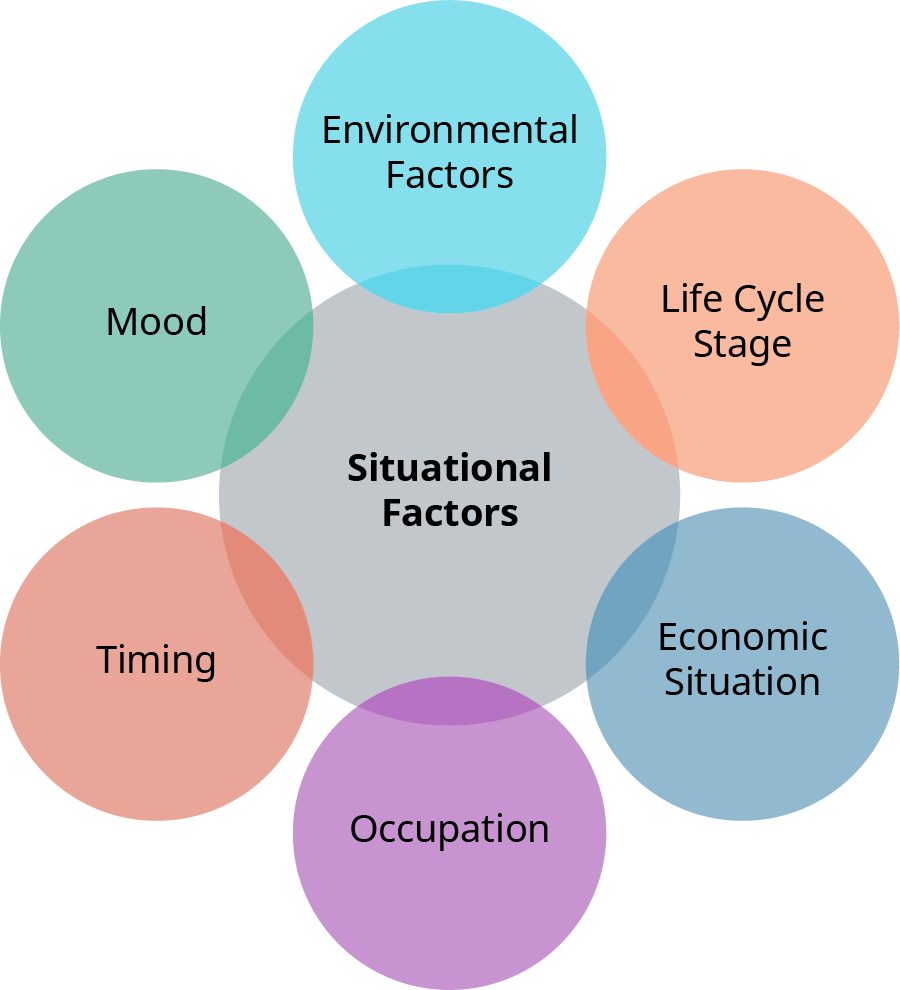
Environmental factors such as music, lighting, ambient noise, and even smells can either discourage or encourage a consumer’s purchase decision. For example, researchers conducted a study on the effect of lighting on consumer purchases in a grocery store. They lit half the store with traditional fluorescent lighting and the other half of the building with LED lighting. Researchers conducted the study over 21 weeks and discovered that consumers bought 25 percent more products on the LED-lit side of the store.[8]
Spatial factors also play a role. The way a product is displayed may make it seem desirable, but a crowded store or a long line at the cash register can suddenly make that same product seem less desirable. Think about it: Have you ever seen a long line to check out at the cash register and put the product you intended to buy back on the shelf because it simply wasn’t worth it to waste your time standing in line?
The social situation of shopping is another situational factor. Did you know that you’re more likely to stop to look at certain products when you’re in the company of a friend as opposed to a parent? The social aspect can even alter the price you’re willing to pay. You might be more inclined to purchase a more expensive product when you’re with a colleague or potential partner than you would if you’re with a friend or spouse.[9]
The goal of your shopping trip is yet another situational factor. If you go to a store to look for a birthday present for your mother, your purpose is totally different than if you’re casually shopping for a new pair of shoes. The reason for shopping dictates the kinds of products customers are willing to interact with at that time and may cause them to bypass certain products they would normally interact with on another shopping trip. This is even true at the grocery store. You’ll interact with products differently if you’re on your weekly shopping trip versus simply going into the store because you’re out of milk.
Much like the purpose of your shopping trip, timing also influences your consumer behavior. If you’re in a rush because it’s Christmas Eve and you haven’t bought a present for your best friend yet, you’ll interact with fewer products than if you have hours to shop. Even if two people are looking for the same type of product, the one in a rush will probably end up with the most accessible product, whereas the leisurely consumer has time to weigh the price and quality of offerings.
Finally, your mood influences your buying behavior. Someone who is feeling sad or stressed interacts differently with products than a happy, relaxed shopper. The same can be said for someone who’s fatigued versus someone who’s full of energy.
Consumer Decision Process
This chapter has examined many of the factors that influence consumer buying behavior, but behind the visible act of making a purchase lies an important decision process that takes place before, during, and after the purchase of a product or service.
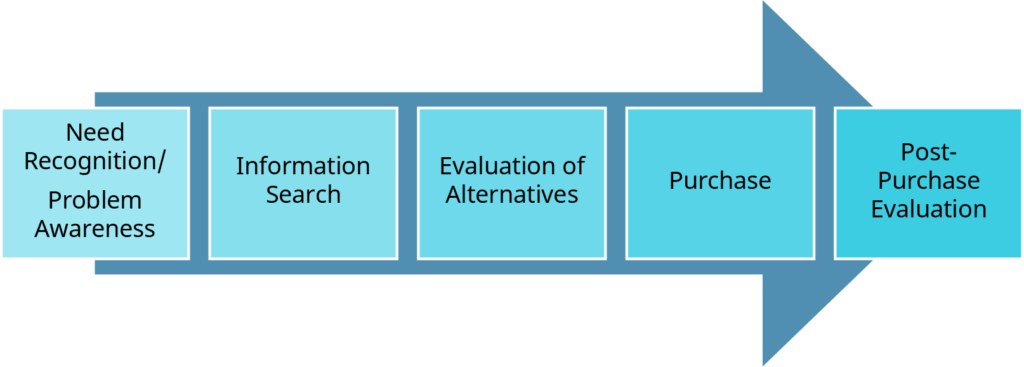
A buyer passes through five stages of the consumer decision process when making choices about which products or services to buy. Let’s examine each, starting at the beginning.
Stage 1: Need Recognition
The buying process starts when you sense a difference between your actual state and your desired state. This is referred to as problem awareness or need recognition. You might become aware of a need through internal stimuli (such as feeling hungry or thirsty when you’re on a long road trip) or external stimuli (such as passing a bakery and smelling the wonderful aroma of cookies baking).
Sometimes recognizing the problem or need is easy. You’ve run out of toilet paper or milk. But other times recognizing the problem or issue is more complicated. For example, think about this first stage in terms of your decision to enroll in college. What was the stimulus that triggered your interest in attending college? Are you a working adult who has recognized that upward advancement in your company won’t happen without possessing a college degree? Have you long aspired to be an entrepreneur, and you wanted to get some business and marketing courses under your belt so that you’re better prepared for the challenges of entrepreneurship? Perhaps a career in marketing has been on your internal radar since high school, and you’ve decided to take the plunge and get your degree in marketing. Or perhaps, after graduating from high school, your parents gave you an ultimatum—either find a job or enroll in college.
Stage 2: Information Search
Now that you’ve identified the problem or need, you’ll be inclined to search for more information. There are two different search states. The milder search state is called “heightened attention,” in which you become more receptive to information about the product or service. The stronger search state is called “active information search,” in which you might do some research about the product or service on the Internet (referred to as an internal search), ask friends and/or family members their opinions (what’s known as an external search), or even visit stores to view and touch the product (called an experiential search).
Keep in mind, of course, that not all needs/problems identified in Stage 1 will require this second stage. If you’ve run out of bread or toilet paper, you’re probably not going to do an information search; rather, you’ll just go to the store to buy what you need, and your information search may be as simple as checking prices at the grocery store to see if your favorite brand is available or another brand is on sale. However, purchase decisions of more consequence will usually trigger an information search of some type.
Again, consider the process you went through in deciding which college to attend. What sources of information did you use to find out about the colleges or universities you considered attending? Did you look at their websites, talk with friends or family who attended that school, or perhaps even visit the campus and meet with an admissions counselor?
Stage 3: Evaluation of Alternatives
Consumers are said to view a product or service as a “bundle of product attributes,” and you evaluate several attributes of a product or service in reaching your purchase decision. For example, if you’re buying a smartphone, you’ll consider factors such as battery life, speed, storage capacity, or price. If you’re booking a hotel, you’ll probably consider its location, cleanliness, free Wi-Fi, whether it has a free breakfast in the morning or a pool, and of course price.
What bundle of attributes did you use when evaluating your college alternatives? You may have considered factors such as location, size of the campus, whether the school had the program of study you wanted, if it had online learning, and cost.
Stage 4: Purchase Decision
This stage involves actually reaching a decision on the purchase of the product or service. One way people navigate all the information, evaluations, and choices in their purchase decision is to use heuristics—mental shortcuts or “rules of thumb.” Heuristics are types of preexisting value judgments that people use to make decisions.
For example, do you believe that the more expensive product is always of higher quality than the lower-priced product? That’s known as the price = quality heuristic. Brand loyalty is another heuristic people use in reaching their purchase decisions. For example, do you eat cereal? Do you always buy the same brand, or do you buy whatever’s on sale or a brand for which you have a coupon? Country of origin is still another heuristic. Given a choice, do you prefer to buy products made in the United States versus products made in other countries?
How did you make your purchase decision to enroll in your college or university? What heuristics did you use?
Stage 5: Post-Purchase Evaluation
After purchasing the product or service, you’ll experience either satisfaction or dissatisfaction. You may have second thoughts after making a purchase decision, and these doubts lead to cognitive dissonance, or buyer’s remorse—tension caused by uncertainty about the correctness of your decision. This may lead you to search for additional information to confirm the wisdom of your decision in order to reduce that tension.
What determines if a consumer is very satisfied, somewhat satisfied, or dissatisfied with his or her purchase? Satisfaction is a function of the closeness between the buyer’s expectations and the product’s perceived performance. If the product’s performance falls short of expectations, you’ll be dissatisfied. If the product’s performance meets your expectations, you’ll be satisfied, and if the product’s performance exceeds your expectations, you’ll be very satisfied.
Think about the purchase decision you made when you decided to enroll in your college or university. Are you very satisfied, satisfied, or dissatisfied with your decision?
Customer Journey Mapping
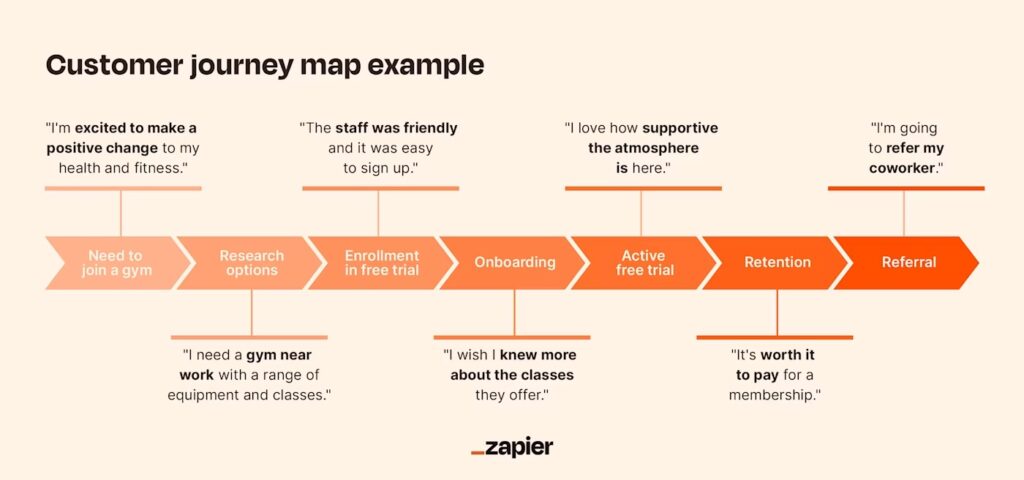
What is a Customer Journey Map?
In our customer-centric world, providing a superior customer experience (CX) is a priority for any organization pursuing real success. Today’s organizations are doing everything they can to better understand their customers. Whether your brand is business-to-business (B2B) or business-to-consumer (B2C); a start-up or corporation; global or local, providing exceptional customer experience is a must. One of the best ways to get to know your target audience is by walking in their shoes and mapping each and every interaction you share. This is where the customer journey map comes in.
A customer journey map is a visualization of an end-to-end customer experience. It’s essentially a visual narrative that allows you to understand each process your customer encounters with your organization, spanning each step from their initial engagement to, hopefully, a long-term relationship. As Matthew Fairweather, director of Matthew Fairweather Ltd., has stated:
Customer journey mapping is really a mixture of art and insight … But that’s just a visual aid. The real work in journey mapping is using all of the customer information and data available to you from across the business and delivering a process and structure to their experience.
A great customer journey map should highlight how your customers discover, research, purchase, interact, and even promote your offerings. One of the easiest places to start is by outlining all the touchpoints your organization has with its target audience. In the graphic below, the touchpoints are listed in the boxes and represent customer interactions as they move through each of the stages. And, as you can see, these touchpoints can be either online or offline.

Simply stated, a customer journey usually includes the following five stages:
- Awareness
A prospective customer learns about an organization, product, or service. In this initial stage, marketers create awareness through ads, events, articles, or other content
- Engagement
A relationship develops between the prospective customer and the organization via several, positive interactions. This is achieved by nurturing leads with targeted content., e.g., on social media, through email marketing, or other events / owned media.
- Conversion
The prospective customer decides to buy a product or service from the organization. By presenting a unique value proposition and creating a sense of urgency, e.g., special offers, marketers can help prospective customers convert.
- Retention
The customer has a strong and loyal relationship with the organization and becomes a regular customer or active user. While often the domain of customer support or customer success, marketers can assist by providing the appropriate training materials, support, and resources to ensure customers are satisfied and stay.
- Advocacy
A regular customer is satisfied with the organization’s products and/or services and recommends them to others. To create advocates, organizations must deliver compelling experiences worthy of sharing. To support these experiences, marketers can provide ready-to-share content.
Please note that depending on your organization, you may choose to rename some of the stages from above or perhaps even break up a stage into multiple stages. For example, if you are in HR and mapping the “customer journey” for recruiting new employees, “Conversion” could be changed to “Application Submitted” and “Engagement” might be broken up into First interview, Second Interview, etc. So, feel free to tweak the specific names and number of stages to best fit your organizational processes. But do make sure that you are capturing all the steps in your target audience’s journey.
In addition to specific stages and touchpoints, a great customer journey map also includes additional information and details. Here are six more areas to consider when building a comprehensive customer journey map:
- Customer’s Perspective
When you build your customer journey map, ensure that you are mapping and presenting everything truly from the customer’s perspective. This is a great opportunity to use the customer personas that you have created to closely map out their customer journeys. Organize the stages to reflect the conversion process from your customer’s (or customer persona’s) perspective, as opposed to your own internal processes. This can often include aspects out of your direct control, such as social media influences, web searches, and steps your customers take even before you enter the picture.
- Customer’s Thoughts, Emotions, Pain Points, and Goals
For every stage of your customer journey map, write out what your customers are thinking, contemplating, feeling (even fearing), struggling with, and what they hope to accomplish. This will help you, as an organization, meet and address those specific needs. Here are a few examples:- Customer Thoughts
Customer thoughts represent what customers are thinking at a specific stage of their customer journey. Examples include:- I hope I can find _____?
- Is this organization credible?
- How do I use _____?
- Is there support post-purchase?
- How does ____ compare to other offerings in the market?
- How much does it cost?
- How long will it take to get it?
- Customer Feelings
Customer feelings reflect what customers might be feeling at a specific stage of their customer journey. Examples include:- Excited – often at the beginning when a “solution” is a possibility
- Curious – usually at some point when doing research or trying to find out more information
- Confused – for complex or complicated products / services
- Hopeful – perhaps after purchase, but before using the product / service
- Impressed – post-purchase
- Frustrated – when things go wrong
- Overwhelmed – too much information
(For visualization purposes, emotions are sometimes represented by emojis.)
- Customer Thoughts
- Customer Pain Points
Customer pain points are specific problems that prospective or existing customers are experiencing at a specific stage in their customer journey. Examples include:- ____ takes too much time. (process pain point)
- ____ is too complex and I don’t understand how to use it. (product/service pain point)
- I can’t find the information I need. (accessibility pain point)
- I can’t connect with the appropriate person. (support pain point)
- It’s too expensive. (financial pain point)
- Customer Goals
Customer goals highlight what a customer is looking to accomplish at a specific stage of their customer journey. Examples include:-
- I want to find out how much it costs.
- I want to solve “this” problem.
- I want to learn about _____.
- I want to buy ____
-
- Customer Activities
What does the customer actually do at every step along the customer journey?
- Content
As you review each stage of your customer journey, think about what content (articles, FAQs, video, white papers, videos, training materials, etc.) you need to provide to address the customer’s issues.
- Time
The length of a customer experience provides important context. Does a typical stage last minutes, days, weeks, or months? How long does your customer remain in a specific stage? A great journey map recognizes that this information is essential and takes time into consideration.
- Key Performance Indicators (KPIs) / Data Collected
At each stage, the organization should think about what data it will collect, measure, evaluate. What are the key performance indicators (KPIs) that show the organization is performing well (or not) in meeting the target audience’s needs at that specific stage? Often organizations will focus on high-level KPIs and outcomes, but by creating KPIs for each stage, an organization can better identify where in the customer journey things are either performing well or not.
- Opportunities
Once mapped out, where are the gaps and the possibilities? The main purpose of any customer journey map is to improve your customers’ experiences and satisfaction. Given all of the above considerations, where is there room for improvement or new opportunities?
If you want to see some very good, visual examples, please read the following articles, Nine Sample Customer Journey Maps – And What We Can Learn from Them and 144 Best Customer Journey Map Templates and Examples.
Hopefully, you now have a better understanding of customer journeys. To better complete your customer personas and customer journeys, you will need to collect and analyze lots of data about your customers. This customer research is critical to the accuracy, precision, and validity of these tools. While the goal of these tools is to improve the customer experience and to make better customer-focused decisions, if the underlying data is not appropriate, recent, and/or accurate, your entire analysis may be flawed. So, if you are planning to use customer personas and customer journey maps as a strategic, decision-making tool, do make sure you have the appropriate data to support it.
Here is a YouTube video, Customer Journey Map Workshop, that does a nice job explaining how data, customer personas, and customer journeys work together. Closed captioning is available on YouTube.
Benefits of a Mapped Customer Journey
Now that you have a more detailed understanding of what a customer journey is and how to track customers as they move through their customer journeys, let’s talk about why you should map the customer journey:
- Consistency of touchpoints across the entire organization
Similar to the customer persona, customer journeys are a valuable tool in understanding your customers and the various touch points across the entire organization. Customer journeys provide a holistic view of your customers and also highlight how the various departments and teams can work together to create a more seamless customer experience. Furthermore, organizations can use a customer journey to ensure consistency across the entire customer journey and a more consistent customer experience.
- Deeper understanding of customers
As mentioned previously, your customer journey should include your customer needs, wants, pain points, and preferences at each specific stage of the journey. By identifying these characteristics, organizations can better provide support, content, and services to address these very needs, wants, pain points, and preferences.
- Closer and stronger customer relationships
Organizations with detailed customer journeys tend to develop closer and more meaningful customer relationships because they know exactly what customers need, when they need it, and where / how they need it. This level of personalization and customer care translates into more loyal customers and ones that often turn into brand advocates.
- Tailored and timely communications
From a marketing communications perspective, knowing what to communicate, when to communicate it, and through which specific channels ensures that marketers are optimizing their return on marketing activities and investments. These activities deliver more personalized and targeted messaging, which can resonate more with target audiences and customer personas.
- More targeted product development
As we mentioned, customer journeys are also a great tool in identifying product or service development opportunities. For these development teams, customer journeys can identify areas where an organization might introduce new products and/or new ways to improve existing products and services to better serve your target audiences. In other words, customer journeys are not just about marketing but about the overarching organizational customer experience.
- Improved identification of cross and up-selling opportunities
From a sales perspective, customer journey maps identify those opportunities to create cross and up-selling opportunities that are complementary. Remember that this should not be the sole focus of your customer journey. However, there are times when complementary products or services will significantly improve the customer experience. Customer journey maps can serve as strategic tools in uncovering these opportunities.
Customer Journey Optimization
While customer journey maps are helpful in identifying new opportunities, they also allow organizations to quickly identify areas to optimize and/or automate processes or communications based on the data. In building your customer journey maps, it is critical to think about the key data that you will collect along the journey and how that data can help in making better organizational decisions. In other words, your customer journey map should always include the key data and analytics that you plan to collect and evaluate at each stage of your journey. By closely analyzing customer journey data, organizations can better assess how customers move from one touchpoint to another and how to make incremental improvements to the customer journey and customer experience.
Key Takeaways
This chapter defined consumer markets and consumer buying behavior and discussed the buyer’s black box, the concept that attempts to mark the pattern consumers follow when making a purchase decision. It also categorized consumer buying behavior into four types: complex buying behavior, dissonance-reducing buying behavior, habitual buying behavior, and variety-seeking buying behavior.
This chapter also looked at the cultural, social, personal, psychological, and situational factors that influence consumer behavior and scrutinized the stages of the consumer decision process.
Finally, a customer journey map is both a discovery and strategic organizational tool. In developing a customer journey map, organizations may discover areas that need improvement or can be supported better. However, a customer journey map can also be used to prioritize which target audiences to pursue or serve better.
- MSG Management Study Guide. (n.d.), accessed August 4, 2021, https://www.managementstudyguide.com/cultural-factors-affecting-consumer-behaviour.htm. ↵
- Editor, “Women vs. Men—Gender Differences in Purchase Decision Making,” zoovu Blog (July 16, 2019), accessed September 19, 2021, https://zoovu.com/blog/women-vs-men-gender-differences-in-purchase-decision-making/. ↵
- Kendall (@kendalljenner) • Instagram photos and videos (n.d.), accessed March 7, 2022, https://www.instagram.com/kendalljenner/. ↵
- Leo Messi (@leomessi) • Instagram photos and videos (n.d.), accessed March 7, 2022, https://www.instagram.com/leomessi/. ↵
- Kendra Cherry, “What Is Personality?” verywellmind, accessed August 4, 2021, https://www.verywellmind.com/what-is-personality-2795416. ↵
- Sallie B. Middlebrook, “Personality and Related Characteristics That Affect Consumer Buying Behavior,” ToughNickel (January 8, 2013), accessed March 7, 2022, https://toughnickel.com/industries/Buyer-Characteristics-and-Consumer-Behavior. ↵
- Lars Perner, “Consumer Behavior: Attitudes,” University of Southern California Marshall (n.d.), accessed March 7, 2022, https://www.consumerpsychologist.com/cb_Attitudes.html. ↵
- “How Grocery Store Lighting Impacts Customer Decisions,” Stratus (May 13, 2021), accessed September 28, 2021, https://www.stratusunlimited.com/news/how-grocery-store-lighting-impacts-customer-decisions/. ↵
- Dana Severson, “Theories of Situational Factors That Influence Customers,” Chron. (November 21, 2017), accessed August 4, 2021, https://smallbusiness.chron.com/theories-situational-factors-influence-customers-78765.html. ↵
the decisions and actions people undertake to buy products or services for personal use.
a set of values or ideologies of a particular community or group of individuals.
the values, ideas, and attitudes that are learned and shared among members of a group.
